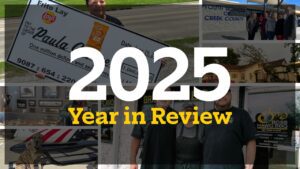In Astronomical terms, when two planets appear to meet each other in the sky, as viewed from Earth, it is called a conjunction. The word conjunction comes from the Latin word “coniunctionem,” meaning to join together. Some of you may remember the Conjunction Junction cartoons from the 1970s. In language, conjunctions relate to clauses brought together in sentences with words such as “and.”
Think of the night sky as a clock, with the Earth at the center, and each celestial body traveling along the clock face at its own rate depending on its orbit speed.
A conjunction between Jupiter and Saturn is called a “great conjunction.” Jupiter and Saturn come together approximately every 20 years but rarely get so close. As NASA explains it, “On the 21st, they will appear so close that a pinkie finger at arm’s length will easily cover both planets in the sky.”
As Henry Throop, an astronomer in the Planetary Science Division at NASA Headquarters in Washington put it, “You can imagine the solar system to be a racetrack, with each of the planets as a runner in their own lane and the Earth toward the center of the stadium. From our vantage point, we’ll be able to see Jupiter on the inside lane, approaching Saturn all month and finally overtaking it on December 21.”

This year-end celestial spectacle has been referred to as the “Christmas star.” This event is rare, the last great conjunction occurred in 1623. What makes this great conjunction exceedingly rare is that it has been nearly 800 years since the alignment of Saturn and Jupiter occurred at night. This 2020 conjunction will allow stargazers around the world to witness this “great conjunction.”
From our vantage point on Earth, the two giant planets will appear very close together, however, they will remain hundreds of millions of miles apart in space. The fact that the conjunction occurs this year on the winter solstice is merely a coincidence.
According to Throop, “Conjunctions like this could happen on any day of the year, depending on where the planets are in their orbits. The date of the conjunction is determined by the positions of Jupiter, Saturn, and the Earth in their paths around the Sun, while the date of the solstice is determined by the tilt of Earth’s axis. The solstice is the longest night of the year, so this rare coincidence will give people a great chance to go outside and see the solar system.”
The closest alignment on December 21 will appear to the viewer to be just a tenth of a degree apart. The planets will be viewed with the naked eye by looking toward the southwest just after sunset.
To observe the conjunction:
Find a spot with an unobstructed view of the sky, such as a field or park. Jupiter and Saturn are bright, so they can be seen even from most cities. An hour after sunset, look to the southwestern sky, 9 degrees above the horizon. Jupiter will appear as a bright star and should be easily visible. Saturn will be slightly fainter and will appear slightly above and to the left of Jupiter until December 21, when Jupiter will overtake it and they will reverse positions in the sky. Although the planets can be seen with the unaided eye, if you have binoculars or a small telescope, you may be able to see Jupiter’s four large moons orbiting the giant planet.










